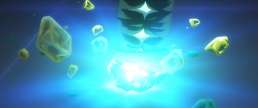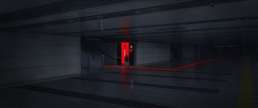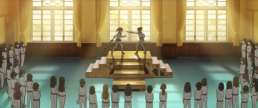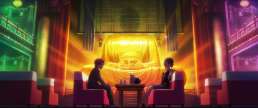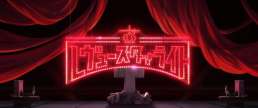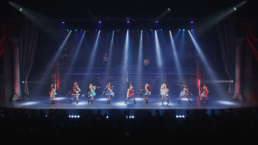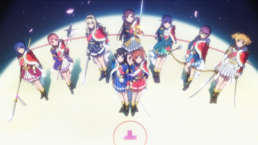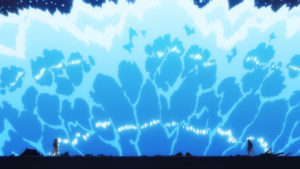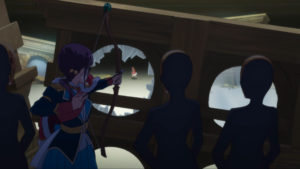Review: Gekijouban Shoujo☆Kageki Revue Starlight Movie
I finally got to see the Revue Starlight Movie, and it was incredible.
 The anime series, which the movie follows up on, was mostly about main character Karen Aijo refocusing on her acting ability in order to star in a lead role of the musical stage play Starlight alongside her childhood friend Hikari. Their determination to fulfill their promise to be stars together helped show the other stage actresses at their musical theater academy what it really meant to be Stage Girls. The show beautifully explored the motivations of each of the nine main cast members by pitting them against each other in one on one magical musical stage battle Revues where they fought with swords and axes and bows, but where their drive and stage presence determined who won the day. Ultimately, Karen and Hikari’s promise brought together their entire class as friends who now realized that being the one exclusive Top Star wasn’t all there was to musical theater. It drove home the message that even when you fail you can always stand up and try again.
The anime series, which the movie follows up on, was mostly about main character Karen Aijo refocusing on her acting ability in order to star in a lead role of the musical stage play Starlight alongside her childhood friend Hikari. Their determination to fulfill their promise to be stars together helped show the other stage actresses at their musical theater academy what it really meant to be Stage Girls. The show beautifully explored the motivations of each of the nine main cast members by pitting them against each other in one on one magical musical stage battle Revues where they fought with swords and axes and bows, but where their drive and stage presence determined who won the day. Ultimately, Karen and Hikari’s promise brought together their entire class as friends who now realized that being the one exclusive Top Star wasn’t all there was to musical theater. It drove home the message that even when you fail you can always stand up and try again.
The movie simply asks: Then what?
 For Karen, the driving force in her life ever since she was a child has been her powerful but naive promise to star beside her friend in one particular play. She did that. So, what happens to her determination and drive once she achieves her goal? For the others, the movie takes a deeper look into places the show left them at in relation to their friends. All of them are graduating soon. Where will they go? What stage will they seek out? How will being pulled apart after graduation affect their relationships with each other?
For Karen, the driving force in her life ever since she was a child has been her powerful but naive promise to star beside her friend in one particular play. She did that. So, what happens to her determination and drive once she achieves her goal? For the others, the movie takes a deeper look into places the show left them at in relation to their friends. All of them are graduating soon. Where will they go? What stage will they seek out? How will being pulled apart after graduation affect their relationships with each other?
Like the series, the movie is more a spectacle than a story. The heart of the movie, as was true of the heart of the show, are its incredibly artistic and deeply layered Revues. In them, stage combat set to awesome musical duets filled with vivid, imaginative imagery see the girls’ desires and motivations clash against each other in order to reveal their true feelings.
 Should they continue to take their acting seriously after they graduate? How do you support one another if you both want to be stars rather than merely a leader and a follower? Can fear, rivalry, and jealously be channeled for a greater good? What happens if one person wants to take a different path than the other wishes for them? How can a honest, heated rivalry help drive people to greater heights? It’s these kinds of things that are explored in the midst of battles set in a variety of locations like the top of speeding subway trains, within olympic sports competitions, or as part of over the top stage dramas set inside other stage dramas.
Should they continue to take their acting seriously after they graduate? How do you support one another if you both want to be stars rather than merely a leader and a follower? Can fear, rivalry, and jealously be channeled for a greater good? What happens if one person wants to take a different path than the other wishes for them? How can a honest, heated rivalry help drive people to greater heights? It’s these kinds of things that are explored in the midst of battles set in a variety of locations like the top of speeding subway trains, within olympic sports competitions, or as part of over the top stage dramas set inside other stage dramas.
Art and Sound
The Revue Starlight Movie is animated beautifully with many different settings featuring tons of bold, bright colors and well thought out designs. This is easily the prettiest Revue Starlight has ever been. With the movie-level budget and lack of week to week tv show deadlines, the team was able to really stretch their legs as compared to the tv series while still matching it stylistically. In some ways, the Revue Starlight art style is a bit simpler than the “animated realism” you see from movies like Belle or Your Name. Backgrounds are a bit more painterly and a bit less complex, for instance. But that doesn’t mean the movie skimps on lighting or location design or animation. Revue Starlight has always been very aware that it’s job is to portray the grandeur of the stage, and the movie does just that on numerous occasions.
The magical Revue battles, which were always the artistic high points of the series, are even more so in the movie. There’s just a bit of extra lavishness to all of them. If the big episode eight fight between Hikari and Banana with its dramatic tension and incredible scene changes was the high bar for the series, it would be something closer to the minimum level of extravagance for most of the Revues in the movie. There are stunning scene changes, killer outfits, great use of wide shots and of close ups, and just a general heaping of theatrics infused within every scene.
The music in the movie is just as wonderful. There are definitely a bunch of callbacks. One of my favorites is a new slow instrumental version of “Knowledge of a Stage Girl” that does a wonderful job of enhancing a tender moment at the party kicking off the girls’ final theater festival. There’s also a bunch of great new music. All the new Revues, of course, have their own full length scores, and they are awesome. The visuals of the Revues are all outstanding, but the music isn’t left behind at all. Some of the most powerful moments come precisely because the way the music and visuals come together.
Throughout it all, this movie is still very much Revue Starlight… meaning it just oozes stunning theatrics from beginning to end, all heavily smothered in layers of intriguing metaphor. Like, why does a tomato explode in the middle of an endless desert just seven seconds into the film? Or, why, at one point, do we see the girls in their normal street clothes standing over themselves in their more ostentatious Revue outfits lying dead soaked in blood, which may or may not be tomato juice. What does it mean for a subway car to transform into a moving battleground? What does it mean to have one person who was engaged in an on-stage duel with a rival to suddenly vanish then reappear while clapping for their opponent from the seats of the audience? It’s kinda amazing how much of the movie’s visual grandeur exists to both be pleasing to the eye but to also prompt further thought. This is a movie that can be analyzed for days and days and still have more to show you.
All In All
 The Revue Starlight Movie, like the show, is different from most any other anime out there. It is theatrics and hand to hand combat and catchy duets and constantly shifting imagery and fourth wall breaks that all serve to peel back the layers of its characters’ motivations. I think it is brilliant, but you have to be willing to both revel in its overwhelming spectacle but also be willing to put all that aside and look beyond the flash to see the interesting character moments waiting beneath. If you’re able to do so, you’ll find a series and a follow up movie that will blow you away with how well they are put together and how much fun they are.
The Revue Starlight Movie, like the show, is different from most any other anime out there. It is theatrics and hand to hand combat and catchy duets and constantly shifting imagery and fourth wall breaks that all serve to peel back the layers of its characters’ motivations. I think it is brilliant, but you have to be willing to both revel in its overwhelming spectacle but also be willing to put all that aside and look beyond the flash to see the interesting character moments waiting beneath. If you’re able to do so, you’ll find a series and a follow up movie that will blow you away with how well they are put together and how much fun they are.
 One word of warning, you absolutely have to have seen the show before you start the movie. The Revue Starlight Movie just assumes you know what happened before and goes straight to what happens next. On the bright side, this means it doesn’t bog down at the beginning reminding you of what you already know, but it also means that you won’t really understand the characters or their actions very well at all if you haven’t seen the show.
One word of warning, you absolutely have to have seen the show before you start the movie. The Revue Starlight Movie just assumes you know what happened before and goes straight to what happens next. On the bright side, this means it doesn’t bog down at the beginning reminding you of what you already know, but it also means that you won’t really understand the characters or their actions very well at all if you haven’t seen the show.
There’s a ton more to talk about, so, if you’ve seen the movie, expand the section below and come Dig Deeper with me!
Each of the movie’s six Revues are awesome, eclectic weldings of singing, dancing, acting, stage combat, music, and orchestration. Like in the series, they all take place in a fictional, magical space, though this time the movie integrates this “Stage of Fate” a bit more directly into the real world whereas the series basically saw it solely located underneath the girls’ musical theater academy. Every one of these Revues is highly metaphorical and highly layered with details big and small.
I promise I did not notice all the nuance and subtle references. Some of the stuff is simply impossible to catch unless you are a native Japanese speaker, and I’m not one. But, I tried my best to share some insights and interpretations of each Revue. Please let me know if you noticed something I didn’t or if you you have a different opinion.
Revue of Annihilation
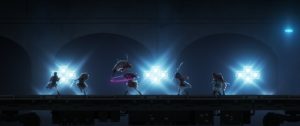 Banana fought and struggled for so long to keep herself and her classmates trapped in a time loop where everyone lived out the same happy year over and over. In the series, that loop was eventually broken and time began moving forward again. If there’s anybody that knows that you have to focus on what comes next, it’s Diba Nana. This whole Revue is her taking out her frustration on her friends who have kinda become more interested in bickering among themselves than focusing on where it is they will each go next. It’s Banana telling them that no matter where they go they need to be prepared for a new fight because just accomplishing a successful theater production in the past doesn’t mean landing a new role on a new stage will be automatic or a given in the future.
Banana fought and struggled for so long to keep herself and her classmates trapped in a time loop where everyone lived out the same happy year over and over. In the series, that loop was eventually broken and time began moving forward again. If there’s anybody that knows that you have to focus on what comes next, it’s Diba Nana. This whole Revue is her taking out her frustration on her friends who have kinda become more interested in bickering among themselves than focusing on where it is they will each go next. It’s Banana telling them that no matter where they go they need to be prepared for a new fight because just accomplishing a successful theater production in the past doesn’t mean landing a new role on a new stage will be automatic or a given in the future.
Banana is one of the most gifted actresses among our nine main Stage Girls and she finally gets a chance to show that off brilliantly. She takes on everyone at once and takes them apart with ease. Pay attention to her lyrics. In the second half of the battle, the words she is singing are direct criticisms of the faults of the other girls as she defeats them in battle. Only Maya, who already understands the coming battles of her next stage, is able to stand up to Banana. It’s fitting then that she is the only one that Banana does not criticize.
 The music here is interesting because it is somehow both frantic but monotone at the same time. I think it’s the perfect representation of Banana. Incredibly talented, but bursting with an over the top intensity that sorta flattens everything out. Both she and the music are a bit too intense to have a proper, normal range.
The music here is interesting because it is somehow both frantic but monotone at the same time. I think it’s the perfect representation of Banana. Incredibly talented, but bursting with an over the top intensity that sorta flattens everything out. Both she and the music are a bit too intense to have a proper, normal range.
Ultimately, Banana is trying to be helpful. Trying to show them that they must chart their own courses or die as Stage Girls. She is even trying to be encouraging to Karen who she almost straight up asks “what will you do next?”. While off the stage, Diba Nana is everyone’s gentle, hard working, lovable “Banana” who cooks them meals and gives them back rubs. But, while on the stage, she is harsh and fearsome, and wholly devoted to her craft. That second one is the Banana we are seeing in this Revue.
Junna’s comment at the end after Banana cuts off her cloak so dismissively relates to how usually Banana is lovable and supportive. It’s rare to see her in full on full intensity acting mode.
Revue of Malice
 In some ways this is still the hardest Revue to wrap my head around. Why are Futaba and Kaoruko fighting again if they made up and were “fine” by the end of their Revue in the series? The answer is they weren’t fine! They just put that fact aside for a while longer.
In some ways this is still the hardest Revue to wrap my head around. Why are Futaba and Kaoruko fighting again if they made up and were “fine” by the end of their Revue in the series? The answer is they weren’t fine! They just put that fact aside for a while longer.
In reality, Kaoruko had been using Futaba for most of their lives. Relying on her. Taking her for granted. Taking advantage of her in so many ways. From having Futaba buy her food and candy, to using her as free transportation, to having her wake her up in the morning and more. Kaoruko took so much and offered so little in return.
And that might have been fine, if Kaoruko had simply cheered Futaba on as her friend devoted herself to becoming a better Stage Girl. Instead, Kaoruko got jealous. And though she got better about fending for herself at the end of their episode, she apparently never really did help or encourage her lifelong friend.
This Revue is a breakup, but it’s also very interesting thematically! In a couple of ways:
1. The beginning with Kaoruko and Claudine is a homage to Samurai movies where the challenger comes to call out their rival in order to duel them and ultimately kill them. I love how both Kaoruko and Claudine play their proper parts thanks to the magic of the Revues.
2. Think about the roles Kaoruko and Futaba play once we reach the cabaret portion of the Revue. In the real world Takarazuka Revue system, which Revue Starlight is heavily based on, the Top Star is always an Otokoyaku. A girl playing a male role. But here we have Kaoruko, someone who earlier in the film was fretting over whether the Auditions had started again because someone else might become Top Star, now playing a Musumeyaku role! A female role. Sure, she is glamorous and sexy and angry, but it is Futaba playing the more prestigious role! That’s important.
 Although this Revue started with Kaoruko and Claudine, I think it is really Futaba’s Revue. “It’s not fair!” She keeps saying. “Why won’t you understand?!” And finally “We can’t go together anymore!” Futaba has decided her own advancement as a Stage Girl is more important than the unfair relationship she has had with Kaoruko all her life. And I say good for her!
Although this Revue started with Kaoruko and Claudine, I think it is really Futaba’s Revue. “It’s not fair!” She keeps saying. “Why won’t you understand?!” And finally “We can’t go together anymore!” Futaba has decided her own advancement as a Stage Girl is more important than the unfair relationship she has had with Kaoruko all her life. And I say good for her!
But there is one thing at the end that shows the love Futaba still has for Kaoruko. She lends Kaoruko her bike. The bike is more than simply a bike. It’s a symbol of all the years Futaba spent supporting Kaoruko. I think it’s Futaba’s way of saying “I can’t be with you right now, but I won’t just abandon you. I’ll still support you the ways I can.” That’s pretty awesome. In the series, Kaoruko learned to assert herself and stop relying on Futaba so much. Hopefully she can learn to appreciate Futaba properly at some point in the future… But for now, I think this may be the most bittersweet of all the Revues as there is little sign that things might one day end well.
Revue of Competition
 “Mahiru has gone nutty again,” someone on Twitter said. But that’s not the case. In this Revue, Mahiru both puts on the performance of her life and does the right thing by convincing Hikari to apologize to Karen for leaving after performing Starlight with her. Mahiru is shown competing in lots of Olympic sports, but her real role here is that of the caring big sister, once more, just like she used to be to her siblings back home.
“Mahiru has gone nutty again,” someone on Twitter said. But that’s not the case. In this Revue, Mahiru both puts on the performance of her life and does the right thing by convincing Hikari to apologize to Karen for leaving after performing Starlight with her. Mahiru is shown competing in lots of Olympic sports, but her real role here is that of the caring big sister, once more, just like she used to be to her siblings back home.
I love the sports angle of the Revue. Especially the way that Hikari and Mahiru keep switching from their Revue costumes to competing in the various sports. The back and forth instant transitions are really cool. The quick sequence that goes from Hikari throwing her dagger to tennis to volleyball to baseball is just incredible! I also wonder a bit if this Olympics Revue was included because Tokyo was hosting the Olympics the year this movie came out in Japan.
 Mahiru does get scary for a bit during this Revue, and its great how the music shifts from her fun, goofy sports theme to something much more frightening, but it’s all an act to scare Hikari into doing the right thing. Into apologizing to Karen both for leaving recently, and maybe for the way she ran away from Karen as a child and never made an effort to be her friend all those years they were apart. Mahiru knows she is not the best Stage Girl. That others will outperform her in singing and dancing and acting. But a hallmark of her character is the desire to help support others and make them smile.
Mahiru does get scary for a bit during this Revue, and its great how the music shifts from her fun, goofy sports theme to something much more frightening, but it’s all an act to scare Hikari into doing the right thing. Into apologizing to Karen both for leaving recently, and maybe for the way she ran away from Karen as a child and never made an effort to be her friend all those years they were apart. Mahiru knows she is not the best Stage Girl. That others will outperform her in singing and dancing and acting. But a hallmark of her character is the desire to help support others and make them smile.
I think Mahiru mainly did this for Karen, to help her when she is confused about where to go next. But, I think Mahiru also did it a little for Hikari and also for herself. She helped spur Hikari on, but she also proved to herself that she can act. Of all the Revues, this is the sweetest because Mahiru is a genuinely sweet person. Need even more proof? At the beginning of the scary part of her performance, Mahiru knocked the head off of Hikari’s Mr. White mascot. But at the end, one of the two figures holding the red finish line for Hikari is her Mr. White with its head taped back on. Mahiru fixed it just for Hikari! 🙂
Revue of Hunting
 This may be my favorite Revue of the movie. Because it is so complex. Because it is emotional. Because it is two characters recognizing the faults in one another. And because, by clashing with each other and by calling each other out, they both find the things they had been looking for. Oh, and the music is excellent, too!
This may be my favorite Revue of the movie. Because it is so complex. Because it is emotional. Because it is two characters recognizing the faults in one another. And because, by clashing with each other and by calling each other out, they both find the things they had been looking for. Oh, and the music is excellent, too!
From Banana’s point of view, Junna was a Stage Girl who was at her brightest not because she was the most talented, but because she never stopped reaching for her goal, even if it was unachievable.
“Even though you couldn’t become the lead, the appearance of you foolishly, insistently reaching out your hand to the lead… It was dazzling.”
That quote is, of course, referring to Junna’s lines about herself from the series:
“Everyone has their own star. Stars that shine. The morning star. Stars that fall. Though I may not yet see my own star, I gaze upward and on this day I, Junna Hoshimi, will take hold of a star of my own.”
So, what changed? Why is Banana now urging Junna to give up completely. I think it’s because Banana see’s Junna’s chosen path as a form of giving up. Everyone else is going to some prestigious theater troupe or acting school. Junna? Her first choice is a literature department at a university! Meaning, she is withdrawing from being a Stage Girl. This plays into the criticism Banana threw at Junna (literally, in the form of her short sword) during the Revue of Annihilation:
“You can’t get by with nothing but words, don’t you know that?”
Now, she says of Junna:
“You’ve been blinded by the stars you can’t reach, and now you can’t see anything.”
Meaning, she thinks Junna was so in awe of others like Maya that she has given up trying to reach their level.
 Now, it’s true Junna was planning to withdraw from theater for a while in order to better understand the stage. But it’s so she can become an even better Stage Girl. That’s something Banana can’t see. Banana has a set role she sees Junna in and it never included Junna giving up.
Now, it’s true Junna was planning to withdraw from theater for a while in order to better understand the stage. But it’s so she can become an even better Stage Girl. That’s something Banana can’t see. Banana has a set role she sees Junna in and it never included Junna giving up.
In some ways Banana has a point. In some ways Junna has relied too much on the words of others and not enough in her own talent. Junna is very smart, but she doubts herself. She always ranks herself lower than others. And even though she claims to want to stand out, to be distinct from the others, Junna has always fought with a bow and almost always from the safety that comes from the height of her flying ring or the shadows at the edge of the stage she tends to hide in.
Banana’s harsh criticism very nearly breaks Junna. Visually, we see this as Banana breaking the crystal on Junna’s bow. It’s only after her best friend and roommate straight up tells her that she doesn’t feel a spark of glimmer in her acting that Junna finally begins to stand up for herself. We finally get to see a truly new side of Junna for the first time. It’s a side that partially agrees with Banana that the words of others are not enough. A side that agrees that just reaching for a star but with no hope of being able to land a lead role is not enough. This new Junna will still reach for her star, but now she will do so until she obtains a lead role. She finally has enough confidence in herself that she really thinks becoming a star is possible.
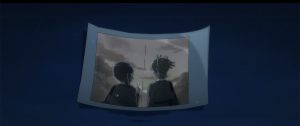 This also isn’t in Banana’s plans. Banana is used to the kind, sweet Junna who strives and strives but is ok with never achieving. She doesn’t understand this new Junna… and Junna calls her out on it! Junna says:
This also isn’t in Banana’s plans. Banana is used to the kind, sweet Junna who strives and strives but is ok with never achieving. She doesn’t understand this new Junna… and Junna calls her out on it! Junna says:
“I don’t need the role you’ve given me.”
And
“The one who is being blinded by the light is you.”
Dang. And, those aren’t just references to their current conflict. Those are references to Banana’s unending time loop from back in the series.
In the anime, when Banana and Junna met on the lawn after Hikari and Karen ended Banana’s reenactments, Junna was just there to be comforting to Banana. She gave Banana quotes that basically said everything was ok because everyone makes mistakes. She held Banana while she cried. She noted that even while controlling the lives of everyone and keeping everything perfect for everyone, Banana was still playing with the script of her time loop behind the scenes. She was still trying to make things even better, Junna acknowledged. Junna never criticized Banana… until now.
The reason Banana trapped everyone in her loop was because she was so blinded by the 99th Starlight that she didn’t want to even try to top it. To her, it was perfect, and by setting everyone’s roles in stone, she could protect everyone from hardship and failure. Junna’s responses about being given a role and about Banana being the one who was blinded are subtle but sharp, jagged criticisms of what Banana did to her and everyone else. What Junna is saying here is everyone, herself included, is trying to move forward while Banana is still blinded by the past. Maybe they aren’t moving forward in the way Banana would choose for them, but where they go and what they do in the future is not Banana’s choice to make. Junna, for the first time, is telling Banana she was wrong to trap them in a perfect world where they couldn’t change or grow. She is pointing out that it was Banana who was so blinded by her experiences that she would prevent her friends from moving forward. That’s pretty harsh from Junna, but I think it’s also pretty fair.
The Revue ends in a very interesting way. From Junna, we see clear confirmation that she has embraced a new confidence and sees herself eventually reaching a leading role on a stage of her own. And from Banana, she says something really neat:
“A brilliance like jewels set ablaze. I’ve finally arrived at it. Thank you Junna.”
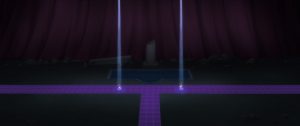 This is very noteworthy! The whole reason Banana looped again and again was to protect everyone from the pains of moving forward, yes, but in her own words, in the seventh episode of the series, she wanted to redo the 99th performance of Starlight because it was:
This is very noteworthy! The whole reason Banana looped again and again was to protect everyone from the pains of moving forward, yes, but in her own words, in the seventh episode of the series, she wanted to redo the 99th performance of Starlight because it was:
“…a brilliance like jewels set ablaze.”
It’s the same words, or very nearly the same words that she says in the movie! By reaching farther and higher than she ever dared reach before, Junna was able to show Banana something that equaled that first perfect performance of Starlight Banana could never manage to get out of her head. That’s very powerful. Banana now truly understands that she can find a new stage and she can find new moments that dazzle her like the 99th Starlight did.
I love that Banana finally found the one thing she could never reach even after hundreds of years of looping, and that it was her friend Junna who gave it to her! I really do hope they get to perform with each other again one day.
Gotta give a callout to the music here as well. It’s really interesting at how strongly it calls back to the Revue of Annihilation until Junna rises to power and shifts everything in her favor. The moment where she takes over the review is very powerful thanks in large part to the build up and climax the music goes through.
Revue of Souls
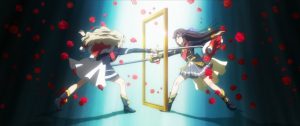 Here it is. The big Maya vs Claudine Revue that we never got during the series. We saw the aftermath of one, with the stage all destroyed and Claudine defeated, but beyond the intro to the show that showed Maya and Claudine crossing swords, we never got to see them fight each other. But now we have. And it was glorious.
Here it is. The big Maya vs Claudine Revue that we never got during the series. We saw the aftermath of one, with the stage all destroyed and Claudine defeated, but beyond the intro to the show that showed Maya and Claudine crossing swords, we never got to see them fight each other. But now we have. And it was glorious.
Sure, the Revue has awesome set design, awesome costumes, and a great call back to Maya’s first Revue with Karen, but it also gives us one thing we never truly got in the series. We get to see what Maya thinks about herself. All throughout the series, Maya Tendo was the perfect Stage Girl. She was always there to help. She always recognized and accepted and appreciated challengers. She was always giving correct advice to people like Kaoruko and Banana. But why? What was in it for Maya?
It turns out what was in it for Maya was living up to the expectations placed on her by everyone else. But, doing so always meant having to limit her own emotions and reign in her own desires. The Perfect Stage Girl is a part that she thought she had to play.
The problem seems to be that Maya has never been defeated. She has always been the best. And because of this she has always been full of pride and arrogance. Even Hikari and Karen weren’t true rivals for Maya. They managed to outshine her and Claudine momentarily, but they were so focused on each other and their childhood promise that who they were up against hardly mattered.
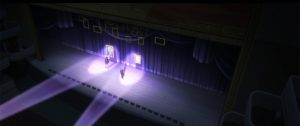 But then along comes Claudine, someone just as dedicated to the stage as Maya is. Someone who challenged Maya directly on the first day they met. Yes, Claudine had a bit of a shock when she found that Maya was her equal and maybe more, but we learned near the end of the series that Maya remembered being impressed by Claudine, as well, on their first meeting.
But then along comes Claudine, someone just as dedicated to the stage as Maya is. Someone who challenged Maya directly on the first day they met. Yes, Claudine had a bit of a shock when she found that Maya was her equal and maybe more, but we learned near the end of the series that Maya remembered being impressed by Claudine, as well, on their first meeting.
Now, the two finally recognize that yes, they are each other’s true rival. That no one else they’ve ever met compares to each other. And Maya in particular finds she has to truly go all out to compete with Claudine. I love that trio of lines they say to each other:
For heroes, there are trials.
For saints, there are temptations.
For me, there is you.
My mind is pulled off to Hercules and Odysseus and Joan of Arc. Epic figures in history that now Maya and Claudine count themselves among. It’s pretty freaking cool!
 There’s another little part of this Revue that I missed the first time. When Maya and Claudine are playing their little board game, Claudine admits that she had lost her love for the stage. She says she was dying inside because she had enjoyed working under Maya so much that she didn’t want to seek out her next stage. This adds some interesting context to Claudine’s part of the Revue. Her desire to have Maya acknowledge her as a true rival is rooted back in the way she almost became content with being in second place during their episode 10 Revue duet.
There’s another little part of this Revue that I missed the first time. When Maya and Claudine are playing their little board game, Claudine admits that she had lost her love for the stage. She says she was dying inside because she had enjoyed working under Maya so much that she didn’t want to seek out her next stage. This adds some interesting context to Claudine’s part of the Revue. Her desire to have Maya acknowledge her as a true rival is rooted back in the way she almost became content with being in second place during their episode 10 Revue duet.
But now, we get a renewed Claudine who, for the first time ever, was able to beat Maya. It was important for Maya to come to terms with her feelings of stoicism and importance, but it was just as important for Claudine to rekindle that spark of competition within herself. By the end of the Revue both Maya and Claudine are truly ready to seek out their next stage and even ready to fight each other as friendly rivals for future roles.
Oh yeah… and that musical callback to Karen and Maya’s Revue of Pride right as Maya and Claudine run at each other… that was amazing! Another great callback was the way Claudine and Maya did their final dramatic introductions of themselves after switching to their Revue uniforms. Each is parroting and mocking the other’s introductions they gave from the latticework of the Tokyo Tower on the Stage of Fate before their Revue in episode ten against Karen and Hikari.
The Final Lines
 And finally, we come back around to Karen and Hikari. This Revue is certainly the most abstract of them all. It’s also one that most directly challenges where things left off in the anime. In some ways, it even reverses some of the strongest positions espoused by the main series.
And finally, we come back around to Karen and Hikari. This Revue is certainly the most abstract of them all. It’s also one that most directly challenges where things left off in the anime. In some ways, it even reverses some of the strongest positions espoused by the main series.
All throughout the movie we’ve been seeing flashbacks of how Karen came to truly love the stage and how her promise with Hikari went from a child’s simplistic promise to a driving force in her life. It wasn’t just a fleeting promise, it was something that Karen held onto tightly for more than thirteen years as she grew from a child to an adult. Was Karen a little naive? Sure. But her faith in her promise was rewarded in the end.
What this Revue points out is that no matter how heartwarming it was in the anime when Karen said, “My stage is you, Hikari,” it was also a deeply flawed position. I love how they showed how incredibly grateful Karen was to Hikari for giving her the inspiration to join school plays and train in dance and acting and to join Seisho Music Academy. But also how they showed just how solely focused Karen was on Hikari to a ridiculous extent.
That scene where both Karen and Hikari turn to the audience watching them is fantastic. It’s a great fourth wall breaking callback to the Giraffe addressing us, the anime viewers, directly in the final episode of the series. Karen made it clear that all this time she barely even noticed the trials and hardships everyone was going through on stage. She never noticed the audience appraising and criticizing her performances. She never noticed the stage lights or any of the other technical challenges that come with acting on a stage. She never even noticed how scared everyone was to be putting themselves out in front of an audience. She ignored all of that because she was so focused on being in a position to do Starlight with Hikari…
…but now they’ve done it. They performed the lead roles in a play of Starlight. Mission accomplished. But, because Karen is as simpleminded as she is, she never thought beyond that point. The anime conveniently never addressed what comes next. It just gave us a happy ending. I love that the movie moves a step beyond and asks: “…and then what?”
What happens next is Karen realizes she doesn’t know what to do. In her perfect world, she and Hikari would be side by side forever. In the real world, Hikari went back to her home in London. In the real world, Karen is a brilliant actress who expected to always have her best friend by her side and now doesn’t. Karen feels dead inside because of all this. She just recently had the time of her life. She did the one thing she’d been looking forward to all her life… but it’s over now and she has nothing else she wants to do.
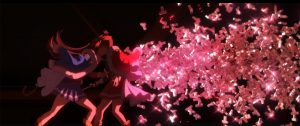 So what fixes Karen? Well, for one thing, Hikari makes a pretty stunning admission. When they were watching Starlight as children, little child actress Hikari was so in awe of it that she was afraid that she might not ever reach that level. So afraid that she nearly gave up, in fact! It took Karen’s dumb raw idealism and the insistence that they promise each other to do their own Starlight to snap Hikari out of it. If Karen hadn’t been there, Hikari might have given up on being a Stage Girl all the way back when she was five. That’s a pretty awesome revelation! It helps give Karen some amount of fulfillment that her promise wasn’t just an empty thing for herself. She unknowingly saved Hikari way back then!
So what fixes Karen? Well, for one thing, Hikari makes a pretty stunning admission. When they were watching Starlight as children, little child actress Hikari was so in awe of it that she was afraid that she might not ever reach that level. So afraid that she nearly gave up, in fact! It took Karen’s dumb raw idealism and the insistence that they promise each other to do their own Starlight to snap Hikari out of it. If Karen hadn’t been there, Hikari might have given up on being a Stage Girl all the way back when she was five. That’s a pretty awesome revelation! It helps give Karen some amount of fulfillment that her promise wasn’t just an empty thing for herself. She unknowingly saved Hikari way back then!
The other thing that fixes Karen is the thing that always fixes Karen: The idea that she can be reborn as a Stage Girl and face the next challenge. Karen, lovable as she is, is kinda a dummy who often does the right things without realizing the deeper why. I think Hikari’s revelation jumpstarted Karen and caused her to look back on all the fun and challenging times she had as a Stage Girl growing up. It caused Karen realize that, no, her stage was not just Hikari. Sure, doing Starlight with Hikari was a huge goal, but Karen was a real Stage Girl and a star long before she and Hikari met again at the start of the anime.
We see a scene where Karen’s three past selves deliver a tomato to her comatose self. The tomatoes all throughout the movie have represented the willingness and desire and sacrifice to take on the challenge of continuing to be a Stage Girl. Karen had ignored that tomato and walked away from those challenges, but now she had it back in hand. So, Karen goes back to the beginning. We literally see her become Position Zero. She has to ride through her brief storm of insecurity and doubt, but she comes through it just fine and is once again reborn as herself, but now she clearly remembers and cherishes everything it took to reach this point.
After all that, Karen’s post-transformation introduction is forward looking to new stages instead of being focused on the stages of Hikari and the Starlight play. Karen now realizes one last thing that she never even considered before. Now that she and Hikari are going their separate ways, they might just end up competing against each other for the same role. Up until now, Karen has maintained that they could pass their Starlight auditions together. Now, Karen realizes that if she ends up going against Hikari she will want to win. It’s Karen’s last step to becoming a true Stage Girl. And yes, this newfound desire to be the best rips apart Karen and Hikari’s Promise Tower, but the promise had already been fulfilled. It will always be great memory the two will share, but it cannot hold up to the reality of the new stages they are heading towards.
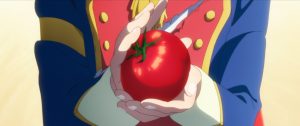 This is quite the departure from the series. It drags Karen a bit more into the real world. One where she knows she might have to defeat others in order to get the roles she wants. Even so, I think Karen will still be the lovable goofball who immediately came to check on and praise Junna for a job well done after their second Revue together. Karen will now try to win, but she won’t seek to destroy her opponents like some stars sometimes do.
This is quite the departure from the series. It drags Karen a bit more into the real world. One where she knows she might have to defeat others in order to get the roles she wants. Even so, I think Karen will still be the lovable goofball who immediately came to check on and praise Junna for a job well done after their second Revue together. Karen will now try to win, but she won’t seek to destroy her opponents like some stars sometimes do.
In the end, the top of the tower lands on Position Zero, and although Karen is empty from having accomplished her Starlight promise, Hikari tosses her a tomato. Karen can now fill herself up on the ambition of being a Stage Girl. She will be alright now, even as she moves into the real world beyond her childhood. And the movie ends.
Except it doesn’t! Stick around for the credits! We get to see where everybody ends up!
– Kaoruko inherits her position as the 12th Generation leader of the Senka-ryu dance school.
– Maya, Mahiru, and Futaba join the New National First Theater Troupe. (Maya can go anywhere she wants, I’m sure, but I’m a little surprised the other two got in!)
– Claudine joined the Theatre de Flamme in France. But, I’m thinking Maya came to visit at least once since Claudine has a cute little dove in her window.
– Junna did not go to a university literature department! She joined a New York Musical and Drama Academy and is dancing and having fun! Yay, Junna!
– And Banana? She joined the Royal Academy of Theatrical Actors… that’s where Hikari is studying! Maybe we can count on Banana (and Hikari?) giving that Judy Knightley, who ended Hikari’s quest to become a Top Star in the anime, a run for her money next time there are auditions? :p
– As for Hikari, she seemed to be traveling the world visiting her friends, but we last see her at her own Position Zero. There’s a ton of little hints throughout the movie that Hikari actually fully quit out of acting after doing Starlight with Karen, but now she is going back to it. I think it would be fun if she and Banana went from super rivals to best friends.
– And Karen? She has a new audition for a new role, but she’ll happily use her experiences of Starlight to help herself along! 🙂
Review: Revue Starlight: The LIVE #1
In Short:
Performed a year before the release of the Revue Starlight anime, the first Revue Starlight stage play tells a similar story complete with some familiar songs and fun choreography. This stage play is notable because the nine core live action stage actresses went on to voice their same roles in the anime.
Though it may just be an unfortunate trick of the camera, a lot of the projected graphics used for character introductions and magical combat effects appear to be very dim in the DVD / Blu-Ray version of the play and are not as impactful or as easy to see as they might have been when viewed in person.
Full Review:
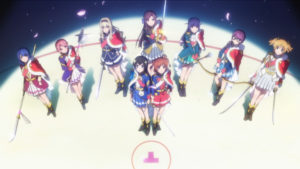 I’ve come to love Revue Starlight, the anime. It combines fun characters, great music, and a strong appreciation of the stage to create an outstandingly unique show. But, Revue Starlight is more than just an anime. At this point, it’s a moderately large multi-medium franchise that includes: Three multi-volume manga, a single cour anime along with an upcoming followup movie, at least four live action stage plays, and an ongoing mobile game that continues to add new stories. It’s the first of these stage plays I’d like to focus on today.
I’ve come to love Revue Starlight, the anime. It combines fun characters, great music, and a strong appreciation of the stage to create an outstandingly unique show. But, Revue Starlight is more than just an anime. At this point, it’s a moderately large multi-medium franchise that includes: Three multi-volume manga, a single cour anime along with an upcoming followup movie, at least four live action stage plays, and an ongoing mobile game that continues to add new stories. It’s the first of these stage plays I’d like to focus on today.
First showing in 2017, “Shōjo Kageki Revue Starlight: The LIVE #1” tells a similar story to the anime where nine stage girls fight in magical Revues in order to try and win the position of the Top Star of their music academy’s 99th class. I wasn’t exactly sure what I was getting into when I decided to watch the stage play. Would it be the same story as the anime but stuck on a more limited stage? Would it be a condensed, unfinished, prototype version of the anime? Would it be a different story altogether? It turns out, it’s actually pretty good on its own merits while still being similar to the anime.
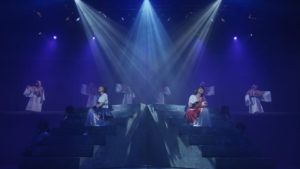 The play opens with our two main characters, Karen and Hikari, as children enjoying the pivotal, tragic scene of the in-universe Starlight stage play. We learn about the two’s promise to become stars of the stage together and of their abrupt childhood parting. We then cut to several years later and are introduced to the eight main member’s of Seisho Music Academy’s 99th class. Each is a different personality and each gets a fun self-sung musical introduction to let the audience know who they are and what they are about. From the proper, rules-following class representative Junna, to the egotistical Maya and Claudine, to the shy Mahiru and Banana, to the larger than life Kaoruko and Futaba, each character rings true. It’s only later that our lead character, Karen, is found sleeping in a separate classroom. Her musical introduction was especially fun and silly!
The play opens with our two main characters, Karen and Hikari, as children enjoying the pivotal, tragic scene of the in-universe Starlight stage play. We learn about the two’s promise to become stars of the stage together and of their abrupt childhood parting. We then cut to several years later and are introduced to the eight main member’s of Seisho Music Academy’s 99th class. Each is a different personality and each gets a fun self-sung musical introduction to let the audience know who they are and what they are about. From the proper, rules-following class representative Junna, to the egotistical Maya and Claudine, to the shy Mahiru and Banana, to the larger than life Kaoruko and Futaba, each character rings true. It’s only later that our lead character, Karen, is found sleeping in a separate classroom. Her musical introduction was especially fun and silly!
After introductions, we get a lot of good character banter that hits on one of the core problems these stage girls face: They only seen each other as on-stage rivals, not partners, and while some shine individually, their inability to work together hampers their performances. The teaching staff, here, take on the roles as something akin to narrators who help move the plot along. Soon the girls are forced into the Trial of Legend where they compete against a chorus of stage hands and extras in musical combat where it again becomes apparent that the eight girls can’t work together properly.
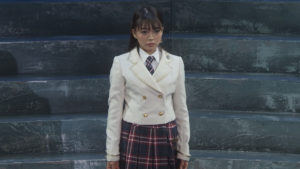 It’s then that Karen’s childhood Hikari arrives as a transfer student from a more prestigious school in London and helps save the day. Karen is thrilled to see her old friend again, but Hikari doesn’t seem to share the same enthusiasm. Eight of the nine soon receive a text message inviting them to special Revue auditions. The only one to not receive the message is the energetic but lazy Karen!
It’s then that Karen’s childhood Hikari arrives as a transfer student from a more prestigious school in London and helps save the day. Karen is thrilled to see her old friend again, but Hikari doesn’t seem to share the same enthusiasm. Eight of the nine soon receive a text message inviting them to special Revue auditions. The only one to not receive the message is the energetic but lazy Karen!
In the auditions, we see character pitted against character in one on one stage combat. Each girl transforms on stage into a military dress uniform and each uses a unique weapon from swords to daggers to even a bow to try and prove that they have more stage presence than their rival. These multiple ongoing battles are a lot of fun, and there’s some cool partially transparent panels set on wheels that are moved around the stage during this part to segment off and highlight the multiple concurrent battles. I thought this part was pretty clever and pretty well done.
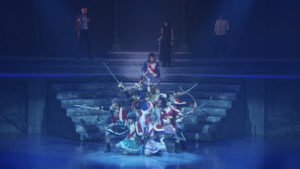 Ultimately, it’s Karen who wants to be friends with everyone who helps unify her class into working together. As partners, the girls put on one last musical combat spectacle as they work together to defeat the chorus. At the very end, the 99th class properly welcomes newcomer Hikari into their ranks, and everything ends happily.
Ultimately, it’s Karen who wants to be friends with everyone who helps unify her class into working together. As partners, the girls put on one last musical combat spectacle as they work together to defeat the chorus. At the very end, the 99th class properly welcomes newcomer Hikari into their ranks, and everything ends happily.
And then the second half of the show starts! You see, this whole event is broken up into the first half, which is a musical stage play that tells a complete story, and the second half, which is a more traditional idol style song and dance performance that’s just one song after another with no plot in between. Some of the songs are certainly catchy, and the dancing and movements are decent, there’s just not as much to say about this second half. You kinda just have to experience the songs for yourself.
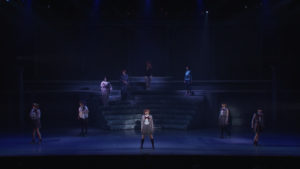 My favorite song in either half of the performance was “Watashitachi no Iru Riyuu” (The Reason We Are Here), which is actually a song that showed up a year later in the anime as “The Star Knows”. The anime version is a duet between Karen and Junna during their big Revue battle. In the stage play, it’s an ensemble song that shifts between each of the nine girls. The first half of the song is slower backed by a powerful piano and string solos. Each of the girls, in turn, sings about why they are stage girls. But, by the end, the song builds in tension and power as we learn that all the girls really have the same goal: they each want to find what makes them unique on stage. As it builds to a climax, percussion comes in and the song jumps quickly to each of the girls thoughts before unifying on them singing the same lines separately but together. It’s terrific!
My favorite song in either half of the performance was “Watashitachi no Iru Riyuu” (The Reason We Are Here), which is actually a song that showed up a year later in the anime as “The Star Knows”. The anime version is a duet between Karen and Junna during their big Revue battle. In the stage play, it’s an ensemble song that shifts between each of the nine girls. The first half of the song is slower backed by a powerful piano and string solos. Each of the girls, in turn, sings about why they are stage girls. But, by the end, the song builds in tension and power as we learn that all the girls really have the same goal: they each want to find what makes them unique on stage. As it builds to a climax, percussion comes in and the song jumps quickly to each of the girls thoughts before unifying on them singing the same lines separately but together. It’s terrific!
I like the Junna / Karen version in the anime since it’s really the first song that reveals the shape of the rest of the show, but I really, really love the song here in live action for it’s great little character moments and powerful conclusion.
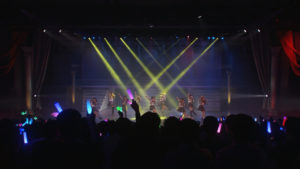 But it’s certainly not the only good song in the play. The earlier “Position Zero e!” Is a fun, upbeat number about the girls activities and goals at the music academy. “Star Divine”, which also appears in the anime as the climatic battle song, serves roughly the same purpose on the live action stage as the big number showing the girls shining together as a team. Finally, the second half of the event kicks off with an upbeat version of a fantastic song called “The Knowledge of a Stage Girl” which was later used in the anime. The animated version is a slow, happy reflection of what it means to be a stage girl. The live action version is considerably faster and more energetic and is used to get the crowd excited for the second half of the show. I like both versions a lot!
But it’s certainly not the only good song in the play. The earlier “Position Zero e!” Is a fun, upbeat number about the girls activities and goals at the music academy. “Star Divine”, which also appears in the anime as the climatic battle song, serves roughly the same purpose on the live action stage as the big number showing the girls shining together as a team. Finally, the second half of the event kicks off with an upbeat version of a fantastic song called “The Knowledge of a Stage Girl” which was later used in the anime. The animated version is a slow, happy reflection of what it means to be a stage girl. The live action version is considerably faster and more energetic and is used to get the crowd excited for the second half of the show. I like both versions a lot!
One final thing I’d like to address is what order this live action stage play and the anime should be watched in. They share a lot of similarities in characters and plot, but they are two distinct things. Ultimately, I think the anime should be watched first. Mostly, because since it has more time to tell its stories, there is more there to be spoiled. There’s a few instances in the stage play that reveal one character’s desires and those same desires play a much larger expanded role in the anime. Not knowing this character’s true desire is a key plot point of the anime, in fact. So, just for that reason alone, I’d recommend the anime first. I also liked having the anime depictions of the characters in my head as I watched the stage girls play the same parts. This isn’t so strange, I don’t think, because the anime version of each character gets a very brief appearance projected on stage during each of the live action girls’ short intros.
All In All:
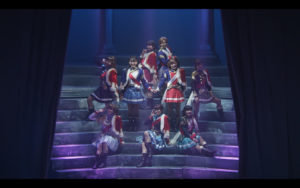 I thought the stage play was great. Each actress stuck to their character well. Each of them had something to do even if they weren’t currently under the spotlight. And, the songs often gave each character a chance to contribute and further highlight their personality. I’d probably give highest marks to the actress who had to physically embody the energetic yet timid Mahiru. Her jittery, smiley performance was very well done. The stage combat was pretty good with slashes and sword locks all supported by clanging sound effects. I’d rate this live action version of Revue Starlight a success. Its core story is somewhat different from the anime that came later, which I’ll talk about more in the Dig Deeper section, but is still strong in its own right even given the much more limited time the play had to work with.
I thought the stage play was great. Each actress stuck to their character well. Each of them had something to do even if they weren’t currently under the spotlight. And, the songs often gave each character a chance to contribute and further highlight their personality. I’d probably give highest marks to the actress who had to physically embody the energetic yet timid Mahiru. Her jittery, smiley performance was very well done. The stage combat was pretty good with slashes and sword locks all supported by clanging sound effects. I’d rate this live action version of Revue Starlight a success. Its core story is somewhat different from the anime that came later, which I’ll talk about more in the Dig Deeper section, but is still strong in its own right even given the much more limited time the play had to work with.
As Claudine Saijo might say: It was très bon!
Now that we’ve covered “was the play good and worth watching”, I’d like to dive into the specific similarities and differences between it and the anime. I’d say that the live action stage play and the anime are telling the same basic story. In both, Karen and Hikari become enamored by the play “Starlight” that they saw together as children and make a promise to one day become stars together. In both, Karen is too lazy to be invited to the Revues and Hikari transfers in devoid of passion because of a past defeat. All the other characters have extremely similar personalities and wishes and desires. The live action play has the stage girls act a little bit more antagonistic towards each other, but that’s resolved by the end of the play.
The biggest difference between the two are just how much more time the anime has to work with. Somethings that can be a quick song lyrics or lines of dialogue in the stage play are expanded to full episodes of the anime. I think it’s pretty clear that the stage play and anime were developed side by side, because those expanded storylines fit in great.
These changes do have some real impacts on the way the different stories flow:
- In the stage play, Futaba and Kaoruko’s fight is interesting because Kaoruko is pretty much in charge the entire time. She knows and recognizes that Futaba is the better stage performer so she uses her own superior acting ability to distract Futaba and get in a sucker punch of a final blow. The anime also has something of this, where Kaoruko tricks Futaba into closing the distance, but it is much more pronounced in the stage play. It’s also important to note that in the stage play, the two’s Revue battle harms their relationship somewhat, while in the anime, their Revue battle both improves Kaoruko’s work ethic and mends her relationship with Futaba.
- In the stage play, we only get one line about why Hikari returned. That maybe she’d been beaten in London and had to come crawling back. The anime shows us that entire series of events. What was a one line explanation in the stage play was turned into one of the biggest core plot points in the entire anime. That’s pretty cool.
- Likewise, the anime greatly expanded Banana’s role to the point that, really, three out of the twelve episodes focus on her while she was just a minor character in the stage play. Hearing live action Banana sing about not wanting to grow up and wishing time would stand still is actually pretty chilling coming from the anime where she straight up put her entire class, if not the entire world, into a time loop specifically so she could relive her class’ first performance of Starlight. Banana planning on repeating the loop is so well integrated into even the early episodes of the anime that I think it would be a shame to tip viewers off with some of the things she sings about in the stage play.
- Finally, any school staff we see in the anime are completely unaware of the Revues, but in the stage play the head of the academy is under orders from the giraffe to pit the girls against one another. This makes even the giraffe a more malevolent character than he is in the anime. He also only appears at the end of the stage play, so he’s quite a bit more mysterious, as well.
I think it’s great to have both versions of the story. It’s great to see a single good story told in different ways that are remolded to better support the medium they are being told in.
Review: Shoujo☆Kageki Revue Starlight Anime
In Short:
On its surface, Revue Starlight is an anime about nine young women who attend an all girls music and stage production school. They learn to sing and dance and act and perform as you might expect. But, when they aren’t attending academic or artistic classes, these same girls are called to fantastical Revue auditions where they must literally fight each other, weapons in hand, in thrilling, character revealing, one-on-one musical stage battles for the right to be their class’ Top Star.
Revue Starlight, to its credit, is built around a detailed, veiled criticism of the Takarazuka Revue style of stage shows and music schools, but some viewers may be unfamiliar with these real world contexts, leaving them lost to the show’s finer points.
Suggested Minimum Watch: 1 episode. The first episode encapsulates both the mundane slice of life and fantastical Revue sides of the show well enough to let you know what you’re getting into.
Full Review:
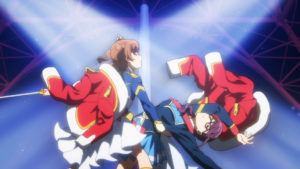 It was the stage battles of Revue Starlight that first caught my eye. They looked like something out of a Magical Girl anime with flashy transformations and superhuman movements. That the show also seemed to focus somewhat on the behind the scenes aspects of a performing arts training school interested me, as well, since I tend to enjoy anime that really know their real world influences. In some ways, I got a bit more than I bargained for as you’ll see in the Dig Deeper segment at the end!
It was the stage battles of Revue Starlight that first caught my eye. They looked like something out of a Magical Girl anime with flashy transformations and superhuman movements. That the show also seemed to focus somewhat on the behind the scenes aspects of a performing arts training school interested me, as well, since I tend to enjoy anime that really know their real world influences. In some ways, I got a bit more than I bargained for as you’ll see in the Dig Deeper segment at the end!
In the first episode, we are introduced to eight girls who attend Seisho Music Academy. They do everything together from attending typical academic classes to participating in all the different dance, acting, and performing arts classes you might find at a music academy. For the most part, the cast is split into pairs early on. Our main character, the energetic yet lazy Karen Ajio gets paired up with the more reserved and responsible Mahiru Tsuyuzaki. The most accomplished dancer and actress in the class, Maya Tendo, often gets paired off with her competitive rival the French-Japanese Claudine Saijo. And so it goes. Each of these pairings end up carrying through the anime’s twelve episodes with transfer student Hikari Kagura throwing a wrench into the balanced mix by the end of the first episode.
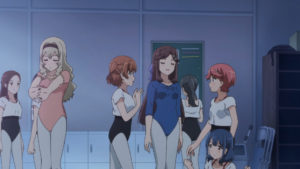 In and out of class, the girls are relatively friendly, but there is an air of competition between some of them that complicates things. Others have different personal issues that need to be worked through. For instance, elegant hometown star Kaoruko Hanayagi’s over reliance on her long time friend Futaba Isurugi eventually becomes an issue. There’s also the soft spoken but intelligent and hard working Junna Hoshimi and the capable but surprisingly motherly Nana Daiba who form a strong bond later in the series after a shared revelation.
In and out of class, the girls are relatively friendly, but there is an air of competition between some of them that complicates things. Others have different personal issues that need to be worked through. For instance, elegant hometown star Kaoruko Hanayagi’s over reliance on her long time friend Futaba Isurugi eventually becomes an issue. There’s also the soft spoken but intelligent and hard working Junna Hoshimi and the capable but surprisingly motherly Nana Daiba who form a strong bond later in the series after a shared revelation.
If Revue Starlight were merely a slice of life show focused solely on these girls and their preparations for their upcoming stage show “Starlight” it would passable but a little dull. All the characters are generally likable, and there are minor conflicts, but there’s just no intense spark between any of them that makes you sit up and take notice. That’s because the show is saving its biggest emotions and character moments for the stage.
At the end of each day of classes, most of the girls receive a strange text message with the cute icon of a giraffe inviting them to special Starlight Revues. The girls enter a not normally there elevator within the school and are brought down deep underground to a giant circular stage surrounded by an even larger pool of water all beneath a bizarrely underground version of Tokyo Tower. Here, their singing, acting, and combat abilities(?!) are pitted against one another in one on one stage battles.
These Revues make up the core strength of the show. They are fantastical and highly reflective of each’s girl’s almost magical stage presence. The Stage of Fate they fight on often shifts and changes in response to the current combatants’ deepest thoughts and desires, and in response to who currently has the upper hand in the performance. Backgrounds, which can be anything from brightly painted cardboard flames to abstract city sets, often magically move in and out as if part of a stage play. The girls themselves transform as if they’re part of a Magical Girl anime. They fight in fancy military dress uniforms instead of the clothes they are wearing when they arrive at each Revue.
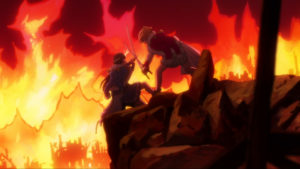 The girls clash their weapons and leap to impossible heights and dodge and tumble as part of these battles, but there is always a strong theatrical element involved. They move with a dancer’s grace and follow dramatic stage direction that sometimes even sees them coordinate their singing and dancing as if part of a stage musical. Despite the clang of weapons, there isn’t any actual violence in these Revues. I can’t remember even a single time that any of the girls actually get hurt in the several Revues they attend. Their goal isn’t to stab or maim their opponents. Instead, they try to cut the tie that holds their opponent’s cape-like overcoat on their shoulder so it falls to the ground.
The girls clash their weapons and leap to impossible heights and dodge and tumble as part of these battles, but there is always a strong theatrical element involved. They move with a dancer’s grace and follow dramatic stage direction that sometimes even sees them coordinate their singing and dancing as if part of a stage musical. Despite the clang of weapons, there isn’t any actual violence in these Revues. I can’t remember even a single time that any of the girls actually get hurt in the several Revues they attend. Their goal isn’t to stab or maim their opponents. Instead, they try to cut the tie that holds their opponent’s cape-like overcoat on their shoulder so it falls to the ground.
The Revues always feature two different girls paired off against each other, but the real thing keeping each Revue interesting is that they have a larger point than just seeing which girl is better with their chosen weapon. The Revues are not really about the physical combat at all. Instead, each Revue highlights the various girls’ interpersonal conflicts. One early Revue highlights how one of the girls came to see being on stage as a way to free herself from her childhood shyness and how her opponent’s newfound success threatens to take the shy girl’s stage, and confidence, away. Another Revue is squarely focused on demonstrating that one girl’s spirit and enthusiasm by themselves are not nearly enough to overcome another girl’s innate talent.
While these Starlight Revues are the heart of the show, Revue Starlight actually manages to tie its flashy combat back into its stage girls’ daily lives in interesting ways. The lessons about kindness, hard work, jealousy, and sacrifice the girls learn during their Revues often change them for the better off the stage. But, more than that, Revue Starlight tells a satisfyingly cohesive overall story with a couple of twists and turns along the way. I appreciate the way it broke up details about the Starlight Revues and about its characters’ motivations and backstories. You don’t learn everything all at once, but the pacing delivers new revelations almost on an episode by episode basis.
If I was to levy any criticism of the show’s plot, it’s that the school’s two top ranked stage girls, Maya and Claudine, don’t get the backstory episodes they deserve. Each has a big personality and have hints at compelling pasts, but we never dive in. And that’s a shame.
Oh, and I guess I should address the elephant in the room. Or, more specifically, the giraffe. These magical Revues are coordinated and overseen by a full-sized, deep-voiced, telepathic talking giraffe. It is the giraffe who introduces girls to the Revues and who sets the schedule for who battles who each day. Yes, his inclusion is strange, and while I don’t want to spoil everything about him, you should listen to what he says, as his plainly stated desires and love of the stage make up a small but important part of the show’s plot.
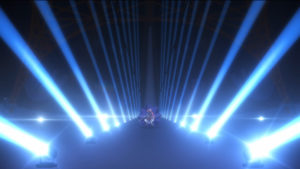 In terms of art and animation, Revue Starlight ranges from good to stunningly great. Once again, the Revues represent its heights. Most start with brilliant character introductions featuring larger than life statements of intent while a dazzling array of spotlights light up the screen in ways that left me breathless. The on-stage combat is also generally well done with nice use of sparks and some fun combat flourishes. Computer animation occasionally pops up, but generally only to animate the spotlights or provide a handful of really good sweeping camera moves that would be difficult to pull off with hand drawn animation alone.
In terms of art and animation, Revue Starlight ranges from good to stunningly great. Once again, the Revues represent its heights. Most start with brilliant character introductions featuring larger than life statements of intent while a dazzling array of spotlights light up the screen in ways that left me breathless. The on-stage combat is also generally well done with nice use of sparks and some fun combat flourishes. Computer animation occasionally pops up, but generally only to animate the spotlights or provide a handful of really good sweeping camera moves that would be difficult to pull off with hand drawn animation alone.
Outside of the Revues, character designs, and, oddly enough, some very tasty depictions of meals are Revue Starlight’s biggest strength. Each of the nine girls is unique and identifiable and some of the food that Nana “Banana” Daiba cooks for her friends just looks delicious.
The only real criticisms I have of Revue Starlight’s art is that the show is well known to have run out of time and budget by the end. It never gets bad, but if you pull yourself out of the moment and watch closely, it does become apparent that the breathtaking combat animations and scene changes of the show’s earlier Revues give way to slow pans across unanimated still shots by the final big battle. The show always reaches for greatness, and still delivers some excellent animation here and there even at its low point, it’s just unfortunate the creative team wasn’t given the budget or time necessary to fulfill the entirety of their vision.
Soundwise, Revue Starlight is uniformly excellent. I’d expect nothing less given that Yoshiaki Fujisawa is involved. His work on A Place Further Than The Universe and Land of the Lustrous was outstanding. The characters, here, have distinct voices and are well acted in both the Japanese and English language tracks. The songs the girls sing in the middle of their Revue battles are catchy and the lyrics they sing at each other are actually surprisingly important and impactful. “Star Divine”, the battle song for episode ten’s Revue, “The Star Knows” sung in the 2nd Revue, and “Re:Create” which plays a pivotal role in the 8th episode are all especially noteworthy. Be sure to turn on the song subtitles or you’ll really will miss out during the series. The song lyrics are very important since they are how each girl primarily expresses her mood and reason for becoming a stage girl.
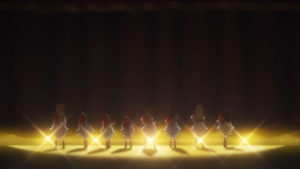 Finally, I’d like to pay special note to Revue Starlight’s opening and its multiple closings. The opening starts with this nice look at the main characters set to a slow stage curtain opening before it transitions through fun slice of life moments and on to showing the type of combat featured in the Revues. The opening song Hoshi no Dialogue (Dialogue of the Stars) is great, too. The endings are neat in that most of the episodes have similar but distinct end credits sequences based on the primary character or characters who just took part in that episode’s Revue.
Finally, I’d like to pay special note to Revue Starlight’s opening and its multiple closings. The opening starts with this nice look at the main characters set to a slow stage curtain opening before it transitions through fun slice of life moments and on to showing the type of combat featured in the Revues. The opening song Hoshi no Dialogue (Dialogue of the Stars) is great, too. The endings are neat in that most of the episodes have similar but distinct end credits sequences based on the primary character or characters who just took part in that episode’s Revue.
All In All:
Revue Starlight is an interesting anime with a unique premise. The way which it uses its magical stage play Revues to resolve various emotional and status based conflicts between its cast members is like nothing I’ve ever seen before. I love that the songs being sung by the characters in the midst of combat often mattered as much or more than the action within their fantastical stage battles. If you love anime with music and theatrics, you should at least give this a one episode try.
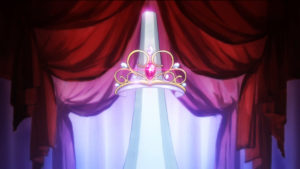 Interestingly, Revue Starlight has yet another hidden side that really pulled me in. Almost everything in the show from the varied heights of its characters to the small pink lens flare glows that are present in almost every single background serve as a veiled criticism of the real world stage shows and music schools of Japan’s Takarazuka Revue. We’ll need to Dig Deeper and enter spoiler territory to really talk about this aspect of the show, but the basics are that Revue Starlight actually speaks out quite strongly against the 100+ year old practices of pitting actresses against each other in competitions where only a handful can reach the highly revered yet highly regulated position of a Top Star.
Interestingly, Revue Starlight has yet another hidden side that really pulled me in. Almost everything in the show from the varied heights of its characters to the small pink lens flare glows that are present in almost every single background serve as a veiled criticism of the real world stage shows and music schools of Japan’s Takarazuka Revue. We’ll need to Dig Deeper and enter spoiler territory to really talk about this aspect of the show, but the basics are that Revue Starlight actually speaks out quite strongly against the 100+ year old practices of pitting actresses against each other in competitions where only a handful can reach the highly revered yet highly regulated position of a Top Star.
Because of all this, I highly encourage you to watch Revue Starlight then come back here to learn more about the sharp criticisms it is voicing, or, if you aren’t afraid of spoilers, continue along with me and learn about the show’s hidden depths so that you can go in with a better understanding of everything you are about to see.
Revue Starlight is actually one of the more interesting shows with one of the most well organized subtexts I’ve ever seen. In addition to its already tightly woven plot about the power of a long held promise, just about every aspect of the show also works to demonstrate the flaws of the real world Takarazuka Revue system. This is going to require a bit of a history lesson, so bear with me.
The Takarazuka Revue is a stage show company that was founded in 1913 by a Japanese railroad tycoon in the city of Takarazuka, Japan. The city had become a tourist city at the final stop of a rail line and in order to further boost the city’s tourist potential, this tycoon created an all girls theater that quickly grew in popularity and status. The theater eventually formed the Takarazuka Music School, an elite acting school similar to the one in the anime. This school only accepts a few of dozen young women each year. The real life school is very strict and the actresses compete against each other to become one of the handful of “Top Stars” maintained by the company at any given time.
There’s an extra wrinkle there, though. Even though the company puts on a wide variety of shows with male and female parts, think Romeo and Juliet or Phantom of the Opera, all the parts are played by female actresses. To accomplish this, the girls joining the school are split up at the end of their first year into Otokoyaku (boy role) and Musumeyaku (girl role) groups. Sadly, only Otokoyaku are eligible to become Top Stars, and typically they are paired with a single Musumeyaku whose job it is to support their performance and popularity until they retire. Tragically, retirement usually happens just a few short years after an actress obtains one of the Top Star positions since it takes so long to reach that level and since once there, the actress is at the top. There’s nowhere left to go.
In the Takarazuka system, young women compete fiercely with each other while, right off the bat, half of them have no hope of earning the most money and fame because only the ones sorted as Otokoyaku even have the potential to become a Top Star. Those are just the rules. That sorting is almost entirely based on physical attributes such as height, vocal tone, and looks. Things like acting ability and singing ability are secondary. To be a Top Star, you have to fit a certain predefined mold and everyone else is treated as significantly lesser than the Top Stars.
Just as there is only a singe Otokoyaku in each troupe, there is also only a single Musumeyaku, as well. You’d think that would make them equal, but it doesn’t. In reality, there is enormous pressure put on the Musumeyaku to support their Otokoyaku. If there’s a mistake the Otokoyaku makes, the Musumeyaku takes the responsibility. If there’s an opportunity to boost the Otokoyaku’s popularity, the Musumeyaku is obligated to pursue it. It’s the Musumeyaku’s job to enhance the desirability and fame of their Otokoyaku, but the reverse is never true.
The Top Star is the only one who truly matters in this system, but there is a ton of pressure and isolation demanded of the Otokoyaku, as well. In the past, there were strict rules like no romantic relationships for anyone at the school, especially either the Otokoyaku or Musumeyaku pairs since they have to remain potentially available to all their fans. Girls at the school or in one of the troupes, especially the Otokoyaku or their Musumeyaku, were also forbidden from receiving or responding to fan mail as well. These kinds of rules and restrictions, combined with the fierce competition to become a Top Star, led to a lot of burnouts, bullying, lawsuits, and even suicides over the years. The Takarazuka Revue has cleaned up its image a good bit in the modern age, and it has cut back on some of its rules, but all these problems still linger over it to some extent.
We can see so many aspects of the Takarazuka Revue system within Revue Starlight. For instance:
Why are Maya Tendo and Claudine Saijo generally seen as the school’s two top students? Why does the always cheerful and motherly Nana “Banana” Diaba have the ability to surpass the both of them as seen later in the series? The answer is that Maya and Banana have all the physical attributes like height and stature they need to become Otokoyaku in the Takarazuka Revue system. Claudine comes close, but ultimately she is too girly and in the real world she would have been seen as a top performing Musumeyaku. And that’s exactly where she ends up! The way Claudine breaks down in episode ten and takes responsibility for Maya’s loss are classic Musumeyaku tendencies drilled into those counterpart women who are forbidden from reaching Top Star status. Sadly, someone as hard working and skilled as Futaba Isurugi would never be considered an Otokoyaku. I believe we see her lose out to Maya, Claudine, and even her friend Kaoruko over the course of the series for largely for these reasons. (Though her loss to Kaoruko is actually its own interesting character study… Their relationship was always based on Futaba supporting and following Kaoruko. If Futaba had won, it would have driven them completely apart which neither actually wanted.)
Similarly, look at the way the Revues are set up. The girls are all battling to become the Top Star, but we later learn that the Top Star usually robs their rivals of their Shine. This is one of the real world criticisms leveled at the Takarazuka Revue system. A small handful of women, one from each acting troupe, achieve Top Star status. These women are the ones to get the fame and press and money while all the other candidates are treated as mere actors. This can be devastating to those who fail to reach the exclusive Top Star position. Revue Starlight takes this even further as we see Hikari Kagura and later Karen Ajio straight up lose the will to continue their careers after losing out to their class’ Top Star. That Karen’s ultimate loss was to her best friend just made things all the more tragic!
With all this in mind, take note of just how often our main character Karen Ajio goes against the Takarazuka Revue system. Her promise to Hikari is for them to share the spotlight… in direct contrast to the Top Star system that recognizes one actress above all others. Her declaration at the end of her transformation sequence, “We will all do Starlight!”, sets it up for all her classmates to join her as equals on the stage which, again, is the opposite of the normal Top Star system.
In contrast, look at Maya and Claudine. Both of them never really had any competition until they met each other. And how do they eventually end up? As an Otokoyaku and Musumeyaku pair determined to claim their first and second place roles from within the Takarazuka Revue system! It’s not an accident that these two represent one of the final obstacle our main characters have to overcome.
It’s all this history and deliberate veiled criticism that I think propels Revue Starlight past its merely average presentation to become one of the more interesting anime I’ve had the pleasure to dig deeper into. But that’s not all there is to say. I didn’t know any of this when I started Revue Starlight, and I almost abandoned it because of that. But then, I caught a series of videos and articles that go into even more detail and saved the show for me:
- Under The Scope’s Building A Stage Girl: Behind The Scenes with Revue Starlight Staff and Staging The Story: The Visual Theater of Revue Starlight
- Emily Rand’s Atelier Emily blog has multiple articles discussing the symbolism of Revue Starlight.
- Andrea Ritsu’s Between The Revues series focusing on the origins and problems with Takarazuka Revue

